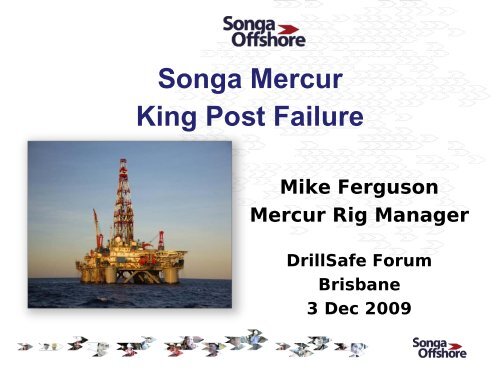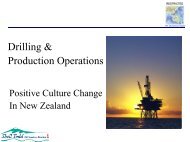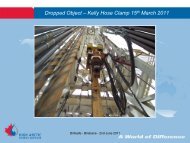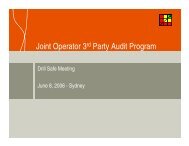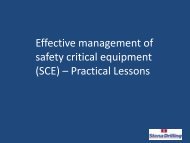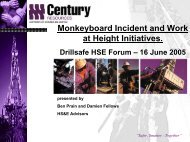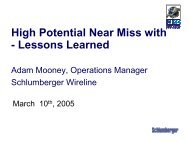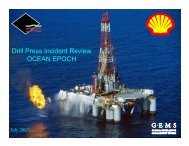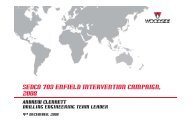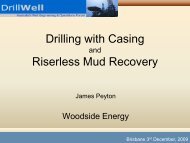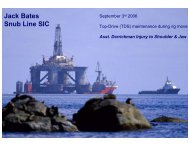Songa Mercur King Post Failure - DrillSafe
Songa Mercur King Post Failure - DrillSafe
Songa Mercur King Post Failure - DrillSafe
You also want an ePaper? Increase the reach of your titles
YUMPU automatically turns print PDFs into web optimized ePapers that Google loves.
<strong>Songa</strong> <strong>Mercur</strong><br />
<strong>King</strong> <strong>Post</strong> <strong>Failure</strong><br />
Mike Ferguson<br />
<strong>Mercur</strong> Rig Manager<br />
<strong>DrillSafe</strong> Forum<br />
Brisbane<br />
3 Dec 2009
<strong>King</strong> <strong>Post</strong> <strong>Failure</strong><br />
1. The <strong>Songa</strong> <strong>Mercur</strong><br />
2. The incident<br />
3. Background to the incident<br />
4. Consequence<br />
5. The investigation<br />
6. Conclusion
<strong>Songa</strong> <strong>Mercur</strong> History<br />
2006 Purchased in USA<br />
The <strong>Songa</strong> <strong>Mercur</strong><br />
2006 Shipyard in Singapore<br />
2007 Arrived in Australia<br />
2007 Commenced work<br />
2 June 09 Date of incident
How did it happen?<br />
The Starboard <strong>King</strong> <strong>Post</strong> Rear<br />
Stay Base Plate separated from<br />
the wing deck<br />
This caused the <strong>King</strong> <strong>Post</strong> to fall<br />
forward and outboard under the<br />
weight of the Flare Boom<br />
The Incident<br />
Starboard Flare Boom
What happened?<br />
The Starboard <strong>King</strong> <strong>Post</strong><br />
failed causing the Flare<br />
Boom to fall into the sea<br />
The Incident<br />
Failed Starboard <strong>King</strong> <strong>Post</strong>
The Incident<br />
Before Recovery
Background to the Incident<br />
Engineering change to flaring installation<br />
The original rig flaring installation was on the aft of the rig, but in 2007 was<br />
relocated to the midship’s wing decks<br />
The relocation of the flare booms required structural engineering of the:<br />
– wing decks<br />
– king posts<br />
An engineering company was contracted to complete the engineering<br />
modification based on a <strong>King</strong> <strong>Post</strong> design from the supplier of the Flare<br />
Boom assembly<br />
Prior to the installation off the <strong>King</strong> <strong>Post</strong>s, project management was<br />
handed over to <strong>Songa</strong> who carried out the tasks of:<br />
– strengthening the wing decks<br />
– installing the king posts & also flare boom cradles
Background to the Incident<br />
Layout of rig illustrating the relocated<br />
position of the Starboard Flare Boom<br />
Legend<br />
Flare boom<br />
<strong>King</strong> post<br />
Stay base plates
Background to the Incident<br />
Events immediately prior to the incident<br />
Well testing operations were being conducted which required the<br />
installation of flare booms<br />
An 85′ long Flare Boom was fitted to the pre-existing boom turntable on the<br />
the Port Wing Deck<br />
An 85′ long Flare Boom was fitted to the pre-existing boom turntable on the<br />
Starboard Wing Deck<br />
When both Flare Booms had been fitted, additional heat suppression<br />
equipment was installed on both Flare Booms<br />
The Starboard Flare Boom was left extended for 64 hours before<br />
hydrocarbons were flared for 15 minutes using the Starboard Burner Head<br />
Three hours later the incident occurred
Actual<br />
The Consequence<br />
Significant damage to flare boom<br />
Potential<br />
Personnel: serious injury or loss of life<br />
Environment: hydrocarbon spill<br />
Equipment: extensive damage to flare boom<br />
Facility: possible fire
The Investigation<br />
A Taproot incident investigation was conducted by a multi disciplined<br />
team lead by <strong>Songa</strong> Offshore which followed 2 lines of investigation:<br />
1. Technical analysis<br />
2. Systems & process analysis<br />
150 x items of evidence were collected<br />
10 x interviews were conducted<br />
In addition, an independent technical study was conducted which<br />
included:<br />
Metallurgical forensic analysis<br />
Engineering design review
The Investigation<br />
Technical Analysis - Root Cause<br />
Root Cause<br />
The original design did not anticipate that the weld to the rear<br />
stay base plate was not uniformly loaded<br />
This was due to the pad eye being located over the caisson wall<br />
and deck stiffener creating hard points to weld, resulting in only a<br />
fraction of the weld being effective
The Investigation<br />
Technical Analysis – Other significant events<br />
• Weld design caused lamellar cracking in the welding zone<br />
• Extra load was added to the flare boom without a MOC<br />
• Weld design assumed a deck thickness of 8 mm not 6 mm<br />
• Project management responsibilities changed without adequate<br />
handover process<br />
• Formal updates were held with NOPSA throughout the investigation
The Investigation<br />
Technical Analysis - Corrective Actions<br />
1.<br />
2.<br />
3.<br />
4.<br />
5.<br />
6.<br />
Redesign the starboard and port king post bracing using the<br />
American Institute of Steel Stress Design – 1989 AISC principles<br />
Ensure that future design scopes for engineering projects (rated as<br />
high risk) include in the design submission an independent review<br />
of methodology and calculations<br />
Ensure all MoC submissions include a project risk assessment<br />
Circulate a Technical Safety Alert re incident<br />
Audit all previous MoC documentation<br />
Recommend findings promulgated to industry
The Investigation<br />
Systems & Process Analysis - Opportunities for Improvement<br />
Opportunity Recommended Action<br />
1. Project Management<br />
needs improvement.<br />
2. Lack of detail in ongoing<br />
maintenances program.<br />
Consider the development of a Project<br />
Management process that includes the<br />
development of procedures and guidelines<br />
Add deck pad eyes to the lifting register and<br />
include inspection and maintenance routines
Conclusion<br />
The incident highlighted the importance of:<br />
having an effective MoC & technical review process<br />
ensuring that all modifications that pose a<br />
significant consequence need to be considered for<br />
review by an external specialist


